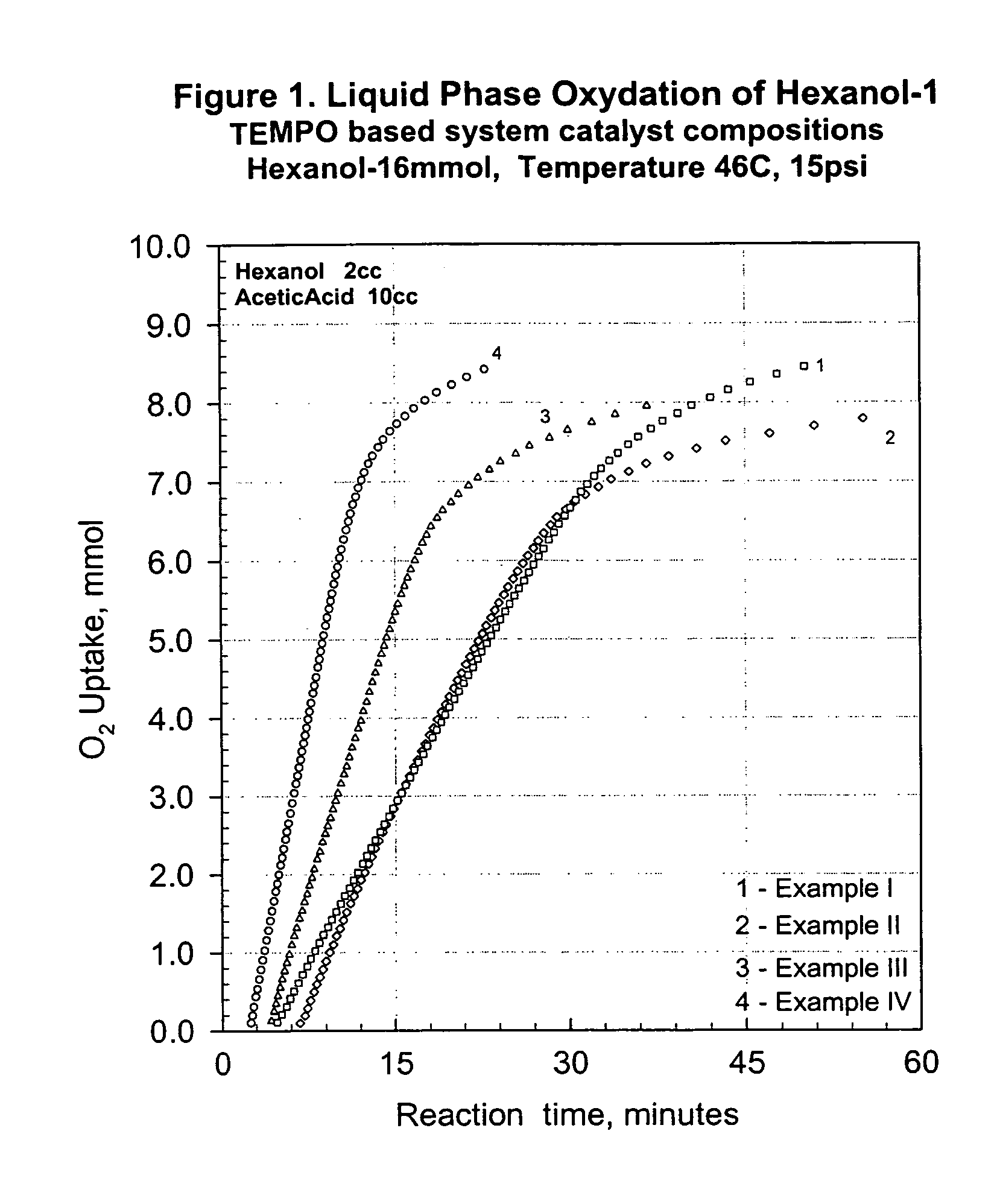Process for transition metal free catalytic aerobic oxidation of alcohols under mild conditions using stable free nitroxyl radicals
- Summary
- Abstract
- Description
- Claims
- Application Information
AI Technical Summary
Benefits of technology
Problems solved by technology
Method used
Image
Examples
example i
[0052]Examples I–IV represent the activity of some TEMPO derivatives used in the catalyst composition of the present invention for the selective oxidation of hexanol-1 to hexanal. The examples I–IV were carried out for illustrative purposes at relatively low loading of the substrate alcohol in the starting reaction solution. A graphical presentation of the oxidation reactions is given in FIG. 1.
[0053]0.0913 g 4-MeO-TEMPO (0.48 mmol), 0.124 g of Mg(NO3)2·6H2O (0.48 mmol) and 0.0086 g N-bromosuccinimide (0.048 mmol) were dissolved in 10 ml of glacial acetic acid and the resulting solution was charged into a 75 ml reaction flask. The flask was sealed and attached to the gas delivering volumetric unit. The catalyst solution was purged with oxygen at least three times and then heated to 46° C. while stirring. When the temperature reached the target value, 2 ml of hexanol-1 (16 mmol) were dosed in using a gas tight syringe. The flask was then pressurized with oxygen to 1 bar (15 psi), the...
example ii
[0054]Example II represents the activity of TEMPO derivative as a component of the catalyst composition—curve 2 in FIG. 1.
[0055]0.0766 g TEMPO (0.48 mmol), 0.124 g of Mg(NO3)2·6H2O (0.48 mmol) and 0.013 g N-bromosuccinimide (0.072 mmol) were dissolved in 10 ml of glacial acetic acid and the resulting solution was charged into a 75 ml reaction flask. The flask was sealed and attached to the gas delivering volumetric unit. The catalyst solution was purged with oxygen at least three times and then heated to 46° C. while stirring. When the temperature reached the target value, 2 ml of hexanol-1 (16 mmol) were dosed in using a gas tight syringe. The flask was then pressurized with oxygen to 1 bar (15 psi), the stirring rate was set to 1200 rpm and the progress of the oxidation was followed by the oxygen uptake, which was continuously monitored and recorded against the time. The recorded oxygen uptake rate was 0.332 mmol O2 / min and the GC analysis after 60 min reaction time showed 96.0% c...
example iii
[0056]Example III represents the activity of 4-hydroxy-TEMPO derivative as a component of the catalyst composition—curve 3 in FIG. 1.
[0057]0.169 g 4-hydroxy-TEMPO (0.96 mmol), 0.311 g of Mg(NO3)2·6H2O (1.2 mmol) and 0.0086 g N-bromosuccinimide (0.048 mmol) were dissolved in 10 ml of glacial acetic acid and the resulting solution was charged into a 75 ml reaction flask. The flask was sealed and attached to the gas delivering volumetric unit. The catalyst solution was purged with oxygen at least three times and then heated to 46° C. while stirring. When the temperature reached the target value, 2 ml of hexanol-1 (16 mmol) were dosed in using a gas tight syringe. The flask was then pressurized with oxygen to 1 bar (15 psi), the stirring rate was set to 1200 rpm and the progress of the oxidation was followed by the oxygen uptake, which was continuously monitored and recorded against the time. The recorded oxygen uptake rate was 0.467 mmol O2 / min and the GC analysis after 45 min reaction...
PUM
| Property | Measurement | Unit |
|---|---|---|
| Partial pressure | aaaaa | aaaaa |
| Pressure | aaaaa | aaaaa |
| Reaction temperature | aaaaa | aaaaa |
Abstract
Description
Claims
Application Information
 Login to View More
Login to View More - R&D
- Intellectual Property
- Life Sciences
- Materials
- Tech Scout
- Unparalleled Data Quality
- Higher Quality Content
- 60% Fewer Hallucinations
Browse by: Latest US Patents, China's latest patents, Technical Efficacy Thesaurus, Application Domain, Technology Topic, Popular Technical Reports.
© 2025 PatSnap. All rights reserved.Legal|Privacy policy|Modern Slavery Act Transparency Statement|Sitemap|About US| Contact US: help@patsnap.com



